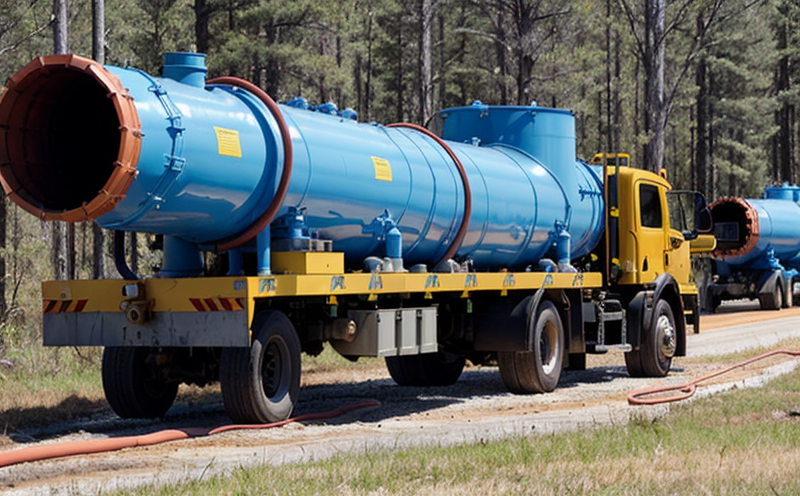ASME BPVC Hydrostatic Pressure Testing of Pipelines
The ASME Boiler and Pressure Vessel Code (BPVC) is a comprehensive set of rules and codes designed to ensure the safe design, fabrication, inspection, testing, and operation of boilers, pressure vessels, piping, and related components. Within this code, Section VIII Division 1 focuses specifically on the construction of high-pressure power vessels and piping systems used in various sectors including Power & Utilities.
One critical aspect covered by ASME BPVC is Hydrostatic Pressure Testing. This testing method involves applying a fluid pressure to a pipeline or vessel beyond its working pressure. The purpose is to verify the integrity of the pipeline under stress, ensuring it can withstand potential overpressurization without failure. This service is essential for pipelines handling natural gas distribution and transportation.
Natural gas pipelines are subject to stringent safety requirements due to their critical role in energy supply. Hydrostatic testing ensures that these systems are safe from internal and external stresses. The test involves filling the pipeline with water or another suitable fluid, pressurizing it beyond its operating pressure, holding this pressure for a specified duration, and then inspecting for leaks.
The ASME BPVC specifies detailed procedures for conducting hydrostatic tests. These include selecting appropriate testing fluids (often water), determining the test pressures (typically 150% to 200% of the maximum allowable working pressure or MAWP), and ensuring the integrity of the pipeline during and after the test.
During the test, real-time monitoring is crucial for detecting any anomalies. This includes listening devices placed at strategic points along the pipeline to detect leaks. Visual inspections are also carried out using cameras to check for visible defects. Post-test evaluations involve assessing the condition of the pipeline for signs of stress or damage.
The results of hydrostatic testing must be documented and recorded in compliance with ASME BPVC requirements. This documentation typically includes test parameters, inspection findings, and any necessary corrective actions. The data serves as a critical record for future reference and regulatory compliance.
Hydrostatic pressure testing is not just about ensuring immediate safety; it also plays a key role in the long-term reliability of pipelines. By identifying potential weaknesses early on, this service helps prevent costly repairs or failures that could disrupt energy supply chains.
For quality managers and compliance officers, understanding these tests is vital for maintaining operational standards. R&D engineers can leverage hydrostatic testing data to refine pipeline designs and materials. Procurement teams benefit from knowing the stringent requirements of these tests when sourcing equipment and materials.
International Acceptance and Recognition
The ASME BPVC Hydrostatic Pressure Testing is widely recognized across the globe for its rigorous standards in ensuring pipeline integrity. This testing method has been adopted by numerous international organizations, including:
- European Union (EU) directives on pressure equipment safety.
- International Maritime Organization (IMO).
- United States Department of Transportation (USDOT).
The ISO 15926 standard for pipeline integrity management also references ASME BPVC guidelines, further emphasizing its importance in the industry. Compliance with these codes ensures that pipelines meet global safety and environmental standards.
Routine hydrostatic testing is a requirement under various legal frameworks worldwide. For instance, the US Occupational Safety and Health Administration (OSHA) mandates such tests for natural gas distribution systems to protect workers and ensure public safety. Similarly, the European Pressure Equipment Directive (PED) requires periodic inspections of pressure equipment like pipelines.
The international acceptance of ASME BPVC standards underscores their significance in promoting a uniform approach to pipeline integrity testing across different jurisdictions. This consistency is crucial for maintaining high standards of safety and reliability globally.
Environmental and Sustainability Contributions
Hydrostatic pressure testing contributes significantly to environmental sustainability by ensuring the safe operation of natural gas pipelines, which are critical infrastructure in our energy mix. By preventing potential leaks and failures, these tests help reduce methane emissions—a potent greenhouse gas that can escape into the atmosphere.
- Methane Leakage Prevention: Proper testing minimizes the risk of methane escaping from pipelines, thereby reducing its impact on climate change.
- Energy Efficiency: Ensuring pipeline integrity through hydrostatic tests helps maintain efficient energy distribution, leading to reduced waste and better utilization of natural resources.
- Resource Conservation: By preventing leaks, these tests help conserve natural gas resources, which are non-renewable and vital for many industries.
In addition to reducing environmental impact, hydrostatic testing supports sustainable practices by promoting the longevity of pipeline infrastructure. Longer-lasting pipelines require fewer replacements, reducing the need for additional resource extraction and minimizing construction impacts on ecosystems.
Moreover, compliance with international standards like ASME BPVC is a step towards achieving global sustainability goals. These codes not only enhance safety but also promote responsible energy management practices that align with broader environmental objectives.
Use Cases and Application Examples
The application of hydrostatic pressure testing in the natural gas distribution sector spans various scenarios where pipeline integrity is paramount. Here are some detailed use cases:
New Construction: Before commissioning a new pipeline, it undergoes hydrostatic testing to ensure that all welds and connections meet design specifications.
Rehabilitation Projects: Following repairs or modifications, pipelines must be tested again to confirm that the work has not compromised their structural integrity. This ensures safe operation post-rehabilitation.
Periodic Inspections: Regular hydrostatic tests are conducted on existing pipelines as part of routine maintenance schedules. These help identify any early signs of wear or corrosion, enabling timely interventions before failures occur.
Emergency Repairs: In the event of a suspected leak or other critical issue, immediate hydrostatic testing can be performed to assess damage and plan appropriate repairs.
Regulatory Compliance: Pipeline operators must meet strict regulatory requirements for pressure vessel safety. Hydrostatic testing is a key component in demonstrating compliance with these regulations.
The real-world implementation of this service involves various stakeholders including pipeline operators, regulators, and safety agencies. Each has a role in ensuring that the tests are conducted correctly and that the results are interpreted accurately to guide necessary actions.





